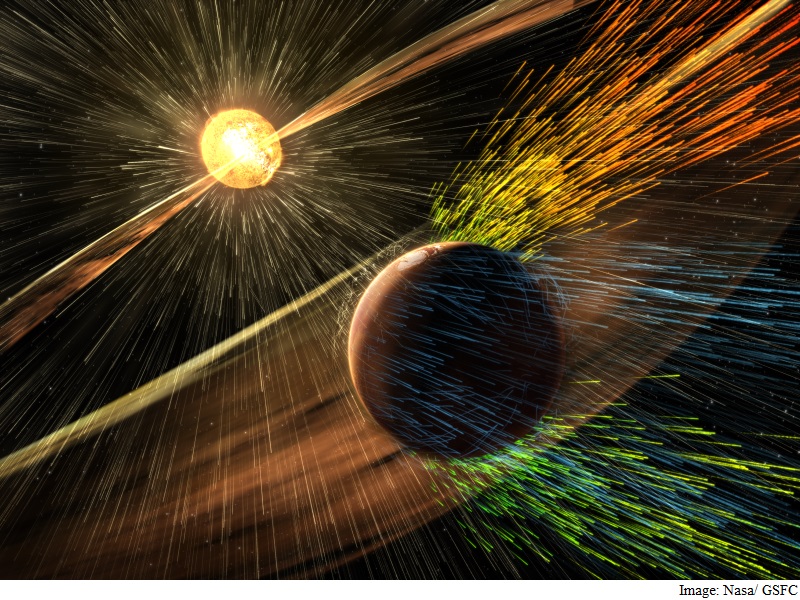- Home
- Science
- Science News
- Spacecraft Reveals How Sun Storms Killed Mars' Atmosphere
Spacecraft Reveals How Sun Storms Killed Mars' Atmosphere

Mars may once have supported life but is now cold and dry, and scientists said Thursday that a stormy sun likely accelerated the loss of the Red Planet's atmosphere.
In fact, researchers believe the thick, protective atmosphere that allowed ancient Mars to be warm and wet billions of years ago may have disappeared far earlier in its history than previously thought.
"Like the theft of a few coins from a cash register every day, the loss becomes significant over time," said Bruce Jakosky, principal investigator on the MAVEN mission at the University of Colorado, Boulder.
"We've seen that the atmospheric erosion increases significantly during solar storms, so we think the loss rate was much higher billions of years ago when the sun was young and more active."
Data from MAVEN, an unmanned spacecraft that has been circling Mars for the past year, was published in scientific studies, including four in the journal Science and 44 more in Geophysical Research Letters.
Instruments aboard the spacecraft are measuring ions in the upper atmosphere of Mars and are also keeping track of solar wind to help understand what influences the escape of gas to space.
"What we are finding is that the rate of loss out the top is relatively slow today, maybe only about 100 grams per second globally, but over time that can be a significant loss," he said.
"And we think that that is the tip of the iceberg so to speak, that early in history the loss rates were much greater and that this mechanism could account for the loss of a very thick early atmosphere."
Big mystery
MAVEN, which stands for Mars Atmosphere and Volatile Evolution, launched in 2013 and began orbiting the Red Planet in September 2014.
Its goal is to help scientists understand one of the solar system's biggest mysteries -- what happened to the water on Mars and the carbon dioxide in its atmosphere several billion years ago?
Mars today has a very thin atmosphere, less than one percent as thick as Earth's.
Previous space missions using robotic rovers and orbiters have shown plenty of geological and geochemical evidence that climate change occurred on Mars.
But knowing more about what drove these changes could shed light on the potential for life on Mars, said John Grunsfeld, associate administrator for the Nasa Science Mission Directorate in Washington.
"Mars appears to have had a thick atmosphere warm enough to support liquid water which is a key ingredient and medium for life as we currently know it," he said.
"Understanding what happened to the Mars atmosphere will inform our knowledge of the dynamics and evolution of any planetary atmosphere."
Data from MAVEN helped show what happened during a large solar storm in March, and indicated that this loss "increases dramatically during a solar storm event, when a coronal mass ejection hits Mars," Jakosky said.
"The variability we are seeing suggests that the escape must have been much greater in the past when the sun was more active and more intense."
The Earth is generally protected from solar flares by its magnetic field.
Mars, which is further from the sun than Earth, may have had a similar magnetic field once, but it was diminished when the planet's core froze.
Another report based on MAVEN data in the journal Science found that auroras are generated on Mars after solar storms, much as they are on Earth in a colorful phenomenon often called the Northern Lights.
"However, where this type of aurora on Earth is driven by magnetism of the poles, the authors suspect that Mars' aurora may be driven by the remnant magnetic field of the crust, creating a more even and diffuse aurora," the study said.
Catch the latest from the Consumer Electronics Show on Gadgets 360, at our CES 2026 hub.
Related Stories
- Samsung Galaxy Unpacked 2025
- ChatGPT
- Redmi Note 14 Pro+
- iPhone 16
- Apple Vision Pro
- Oneplus 12
- OnePlus Nord CE 3 Lite 5G
- iPhone 13
- Xiaomi 14 Pro
- Oppo Find N3
- Tecno Spark Go (2023)
- Realme V30
- Best Phones Under 25000
- Samsung Galaxy S24 Series
- Cryptocurrency
- iQoo 12
- Samsung Galaxy S24 Ultra
- Giottus
- Samsung Galaxy Z Flip 5
- Apple 'Scary Fast'
- Housefull 5
- GoPro Hero 12 Black Review
- Invincible Season 2
- JioGlass
- HD Ready TV
- Laptop Under 50000
- Smartwatch Under 10000
- Latest Mobile Phones
- Compare Phones
- OPPO Reno 15 Pro Max
- Honor Win RT
- Honor Win
- Xiaomi 17 Ultra Leica Edition
- Xiaomi 17 Ultra
- Huawei Nova 15
- Huawei Nova 15 Pro
- Huawei Nova 15 Ultra
- Asus ProArt P16
- MacBook Pro 14-inch (M5, 2025)
- OPPO Pad Air 5
- Huawei MatePad 11.5 (2026)
- Xiaomi Watch 5
- Huawei Watch 10th Anniversary Edition
- Acerpure Nitro Z Series 100-inch QLED TV
- Samsung 43 Inch LED Ultra HD (4K) Smart TV (UA43UE81AFULXL)
- Asus ROG Ally
- Nintendo Switch Lite
- Haier 1.6 Ton 5 Star Inverter Split AC (HSU19G-MZAID5BN-INV)
- Haier 1.6 Ton 5 Star Inverter Split AC (HSU19G-MZAIM5BN-INV)

















